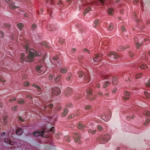“We have some evidence growing now that this might be a viable alternative choice,” she said, “particularly when you think about a patient who’s maybe [in] their second or third flare of nephritis.”
Another induction trial out of Asia, a multi-center, open-label study of 360 patients published in 2015, found that a higher percentage of patients (45.9%) on a combination of tacrolimus and MMF reached complete remission than those on cyclophosphamide (25.6%). Dr. Merrill described it as “one of the most exciting papers published for nephritis in the last year and a half.”4
Dr. Merrill asked the audience how many used the two drugs together in difficult cases, and some hands went up.
“It’s starting to happen,” she said. “With or without an evidence base, we’ve gone ahead and become mixed martial artists because our patients aren’t doing so well.”
Antibodies & Protein as Predictors
A recent study found that the odds ratio of treatment failure during induction was 12.7 if patients were positive for anti-dsDNA antibodies at the start of the induction period, and 8.3 for the maintenance period. There were also heightened risks of treatment failure—2.9 OR and 3.5 OR for induction and maintenance, respectively—if the antibody levels weren’t reduced within eight weeks.5
Reducing proteinuria by at least 50% was also associated with better long-term outcomes.6
“Back in the old days when I trained in rheumatology, we were all following the protein, and I don’t think that’s changed,” Dr. Merrill said.
Genetics
Intriguing findings have also emerged in pharmacogenetics recently, she said.
One study found that 44% of those with a GSTA1*A CT heterozygous mutation had a higher non-remission rate (44%) than those without the mutation (20%). The mutation correlated with less active metabolite cyclophosphamide in these patients, suggesting a possible therapeutic remedy.7
“This may be something we can fix by dosing,” Dr. Merrill said.
In another study, patients with a certain variant of the CYP3A5 gene had higher levels of tacrolimus in their blood than other patients, exposing them to greater risk of toxicity and renal dysfunction.8 This could offer another opportunity to solve a problem with a dose adjustment, Dr. Merrill said.
Looking at the full picture of a patient—background drugs, clinical presentation, ethnicity, genetic makeup—offers the nimble clinician a chance to try to optimize treatment, she said.
“I don’t think anybody here,” she said, “really wants to be using cyclophosphamide or endless steroids in our patients too far out into the future.”
